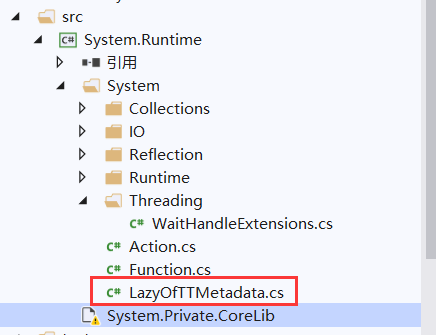Core源码(三) Lazy<T>
Lazy<T>解决什么问题?
1、大对象加载
考虑下面的需求,有个对象很大,创建耗时,并且要在托管堆上分配一大块空间。我们当然希望,用到它的时候再去创建。也就是延迟加载,等到真正需要它的时候,才去加载。
显然,这里需要加一个中间层,将大对象封装起来,暴露接口,开始并不创建大对象,等到用户真正访问对象的时候,再去创建。另外,这个中间层应该可以封装不同类型的大对象,因此需要类模版。Lazy<T>就是为了解决这个问题。
典型的使用
public Lazy<AccountService> AccountServ = new Lazy<AccountService>();
public Lazy<ProductService> ProductService = new Lazy<ProductService>();
2、将委托或者方法对象保存,并在需要的时候调用。
private readonly Lazy<IDbConnection> _connectionLazy;
public CallHistoryRepository(ConnectionFactory connectionFactory)
{
_connectionLazy = new Lazy<IDbConnection>(()=>connectionFactory.Connection);
}
一旦使用.Vale,那么对应的变量就会被实例化,IsValueCreated属性也就变成了true。
实现自己的Lazy<T>
在.NET Framework 4.0之前,大对象就是存在的,那么对于一个大型系统而言,怎么样对付一个大对象呢。主要有两点:延迟加载和即时清理。前者解决创建问题,后者解决回收问题。
那么在来看Lazy<T>的.NET Framework实现之前,我们先来自己实现一个简单的Lazy<T>吧。
class MyLazy<T> where T : new()
{
private T value;
private bool isLoaded;
public MyLazy()
{
isLoaded = false;
}
public T Value
{
get
{
if (!isLoaded)
{
value = new T();
isLoaded = true;
}
return value;
}
}
}
这应该是最简单版本的Lazy<T>了,没有线程安全检测,只有着访问时创建真实对象,可是对于我们一般的应用来说也许就已经足够了。
.NET Lazy<T> 实现
.NET Core和我们的实现,有两点主要的不同:
1、 引入了Boxed内部类:
[Serializable]
private class Boxed
{
// Fields
internal T m_value; // Methods
[TargetedPatchingOptOut("Performance critical to inline this type of method across NGen image boundaries")]
internal Boxed(T value)
{
this.m_value = value;
}
}
该内部类取代了我在上面实现中的泛型约束,使之更通用。
但是我们也应该注意到,如果T为结构体,那么由于T很大,所以装箱拆箱反而也许是个更耗费效率的事情,因此,个人建议,对值类型慎用Lazy<T>。
2、 线程安全的控制
在线程安全的控制选项中,.NET Framework为我们提供了这样的枚举选项:
public enum LazyThreadSafetyMode
{
None,
PublicationOnly,
ExecutionAndPublication
}
默认值为ExecutionAndPublication
枚举选项MSDN介绍如下
http://msdn.microsoft.com/en-us/library/system.threading.lazythreadsafetymode%28VS.100%29.aspx
isThreadSafe则应用于多线程环境下,如果isThreadSafe为false,那么延迟加载对象则一次只能创建于一个线程。
Lazy<T>源码
System.Runtime命名空间下
由于core中的lazy源码我只找到了下图这个,再往下lazy的实现并没找

所以我使用.Net 4.5的lazy源码

一、最常使用的属性Value
[DebuggerBrowsable(DebuggerBrowsableState.Never)]
public T Value
{
get
{
Boxed boxed = null;
if (m_boxed != null )
{
// Do a quick check up front for the fast path.
boxed = m_boxed as Boxed;
if (boxed != null)
{
return boxed.m_value;
}
LazyInternalExceptionHolder exc = m_boxed as LazyInternalExceptionHolder;
Contract.Assert(m_boxed != null);
exc.m_edi.Throw();
}
return LazyInitValue();
}
}
//null --> value is not created
//m_value is Boxed --> the value is created, and m_value holds the value
//m_value is LazyExceptionHolder --> it holds an exception
private object m_boxed;
如果m_boxed有值,就直接装箱返回对应值(这里就要注意值类型装箱的性能损失了)。这个装箱是为了检验下m_boxed的值,因为其中有可能是异常。
二、LazyInitValue方法
如果m_boxed为空,就调用LazyInitValue方法,这里有针对线程安全模式的判断
/// <summary>
/// local helper method to initialize the value
/// </summary>
/// <returns>The inititialized T value</returns>
private T LazyInitValue()
{
Boxed boxed = null;
LazyThreadSafetyMode mode = Mode;
if (mode == LazyThreadSafetyMode.None)
{
boxed = CreateValue();
m_boxed = boxed;
}
else if (mode == LazyThreadSafetyMode.PublicationOnly)
{
boxed = CreateValue();
if (boxed == null ||
Interlocked.CompareExchange(ref m_boxed, boxed, null) != null)
{
// If CreateValue returns null, it means another thread successfully invoked the value factory
// and stored the result, so we should just take what was stored. If CreateValue returns non-null
// but we lose the ---- to store the single value, again we should just take what was stored.
boxed = (Boxed)m_boxed;
}
else
{
// We successfully created and stored the value. At this point, the value factory delegate is
// no longer needed, and we don't want to hold onto its resources.
m_valueFactory = ALREADY_INVOKED_SENTINEL;
}
}
else
{
object threadSafeObj = Volatile.Read(ref m_threadSafeObj);
bool lockTaken = false;
try
{
if (threadSafeObj != (object)ALREADY_INVOKED_SENTINEL)
Monitor.Enter(threadSafeObj, ref lockTaken);
else
Contract.Assert(m_boxed != null); if (m_boxed == null)
{
boxed = CreateValue();
m_boxed = boxed;
Volatile.Write(ref m_threadSafeObj, ALREADY_INVOKED_SENTINEL);
}
else // got the lock but the value is not null anymore, check if it is created by another thread or faulted and throw if so
{
boxed = m_boxed as Boxed;
if (boxed == null) // it is not Boxed, so it is a LazyInternalExceptionHolder
{
LazyInternalExceptionHolder exHolder = m_boxed as LazyInternalExceptionHolder;
Contract.Assert(exHolder != null);
exHolder.m_edi.Throw();
}
}
}
finally
{
if (lockTaken)
Monitor.Exit(threadSafeObj);
}
}
Contract.Assert(boxed != null);
return boxed.m_value;
}
三、CreateValue方法
返回一个实例对象T,采用传入的func方法,这里会对是否已经返回做出判断,如果已经返回,就返回null
/// <summary>Creates an instance of T using m_valueFactory in case its not null or use reflection to create a new T()</summary>
/// <returns>An instance of Boxed.</returns>
private Boxed CreateValue()
{
Boxed boxed = null;
LazyThreadSafetyMode mode = Mode;
if (m_valueFactory != null)
{
try
{
// check for recursion
if (mode != LazyThreadSafetyMode.PublicationOnly && m_valueFactory == ALREADY_INVOKED_SENTINEL)
throw new InvalidOperationException(Environment.GetResourceString("Lazy_Value_RecursiveCallsToValue"));
Func<T> factory = m_valueFactory;
if (mode != LazyThreadSafetyMode.PublicationOnly) // only detect recursion on None and ExecutionAndPublication modes
{
m_valueFactory = ALREADY_INVOKED_SENTINEL;
}
else if (factory == ALREADY_INVOKED_SENTINEL)
{
// Another thread ----d with us and beat us to successfully invoke the factory.
return null;
}
boxed = new Boxed(factory());
}
catch (Exception ex)
{
if (mode != LazyThreadSafetyMode.PublicationOnly) // don't cache the exception for PublicationOnly mode
m_boxed = new LazyInternalExceptionHolder(ex);
throw;
}
}
else
{
try
{
boxed = new Boxed((T)Activator.CreateInstance(typeof(T))); }
catch (System.MissingMethodException)
{
Exception ex = new System.MissingMemberException(Environment.GetResourceString("Lazy_CreateValue_NoParameterlessCtorForT"));
if (mode != LazyThreadSafetyMode.PublicationOnly) // don't cache the exception for PublicationOnly mode
m_boxed = new LazyInternalExceptionHolder(ex);
throw ex;
}
}
return boxed;
}
Core源码(三) Lazy<T>的更多相关文章
- 一起来看CORE源码(一) ConcurrentDictionary
先贴源码地址 https://github.com/dotnet/corefx/blob/master/src/System.Collections.Concurrent/src/System/Col ...
- 一个由正则表达式引发的血案 vs2017使用rdlc实现批量打印 vs2017使用rdlc [asp.net core 源码分析] 01 - Session SignalR sql for xml path用法 MemCahe C# 操作Excel图形——绘制、读取、隐藏、删除图形 IOC,DIP,DI,IoC容器
1. 血案由来 近期我在为Lazada卖家中心做一个自助注册的项目,其中的shop name校验规则较为复杂,要求:1. 英文字母大小写2. 数字3. 越南文4. 一些特殊字符,如“&”,“- ...
- ASP.NET Core[源码分析篇] - Authentication认证
原文:ASP.NET Core[源码分析篇] - Authentication认证 追本溯源,从使用开始 首先看一下我们通常是如何使用微软自带的认证,一般在Startup里面配置我们所需的依赖认证服务 ...
- ASP.NET Core源码学习(一)Hosting
ASP.NET Core源码的学习,我们从Hosting开始, Hosting的GitHub地址为:https://github.com/aspnet/Hosting.git 朋友们可以从以上链接克隆 ...
- asp.net core源码地址
https://github.com/dotnet/corefx 这个是.net core的 开源项目地址 https://github.com/aspnet 这个下面是asp.net core 框架 ...
- ASP.NET Core[源码分析篇] - WebHost
_configureServicesDelegates的承接 在[ASP.NET Core[源码分析篇] - Startup]这篇文章中,我们得知了目前为止(UseStartup),所有的动作都是在_ ...
- ASP .NET CORE 源码地址
ASP .NET CORE 源码地址:https://github.com/dotnet/ 下拉可以查找相应的源码信息, 例如:查找 ASP .NET CORE Microsoft.Extension ...
- DOTNET CORE源码分析之IOC容器结果获取内容补充
补充一下ServiceProvider的内容 可能上一篇文章DOTNET CORE源码分析之IServiceProvider.ServiceProvider.IServiceProviderEngin ...
- AQS源码三视-JUC系列
AQS源码三视-JUC系列 前两篇文章介绍了AQS的核心同步机制,使用CHL同步队列实现线程等待和唤醒,一个int值记录资源量.为上层各式各样的同步器实现画好了模版,像已经介绍到的ReentrantL ...
随机推荐
- 【安富莱】V6,V5开发板用户手册,重在BSP驱动包设计方法,HAL库的框架学习,授人以渔(2019-11-04)
说明: 1.本教程重在BSP驱动包设计方法和HAL库的框架学习,并将HAL库里面的各种弯弯绕捋顺,从而方便我们的程序设计. 2.本次工程延续以往的代码风格,从底层BSP驱动包到应用代码,变量命名,文件 ...
- 05-文档编辑与yum命令
一.Linux vi/vim vi是所有的Unix系统都会有,但是目前我们使用最多的是vim编辑器.vim具有程序编辑的能力,可以主动以字体颜色辨别语法的正确性. vim是从vi发展出来的一个文本编辑 ...
- table-layout:fixed
table-layout: fixed; 在table上设置上面属性后,如果不设置td的宽度,那么所有td的宽度平分总table宽度.如果设置了td的宽度,则以设置的宽度为准. table-layou ...
- 从七个方面,面试BAT大厂高级工程师,纯干货!
转载注明:https://blog.csdn.net/WantFlyDaCheng/article/details/100078782 一.框架是重点,但别让人感觉你只会山寨别人的代码 二.别单纯看单 ...
- ASP.NET Core 2.2 WebApi 系列【五】MiniProfiler与Swagger集成
MiniProfiler 是一款性能分析的轻量级程序,可以基于action(request)记录每个阶段的耗时时长,还是可以显示访问数据库时的SQL(支持EF.EF Code First)等 一.安装 ...
- (转)RocketMQ工作原理
原文:https://blog.csdn.net/lyly4413/article/details/80838716 1.消息中间件的发展: 第一代以ActiveMQ为代表,遵循JMS(java消息服 ...
- Java每日一面(Part1:计算机网络)[19/10/13]
作者:晨钟暮鼓c个人微信公众号:程序猿的月光宝盒 1.说说TCP三次握手 1.0 在此之前,什么是TCP? TCP(传输控制协议) 1.面向连接的,可靠的,基于字节流的传输层通信协议 2. ...
- 原生js对cookie的增删改查
一.增 document.cookie = cname + "=" + cvalue + ";expires=" + expires + ";path ...
- JS Switch
JS Switch switch 语句用于基于不同的条件来执行不同的动作. switch(n) { case 1: 执行代码块 1 break; case 2: 执行代码块 2 break; defa ...
- Android 单选列表对话框 setSingleChoiceItems
private Button button; private final CharSequence[] items = { "北京", "上海", " ...
